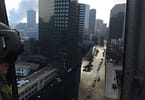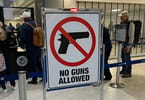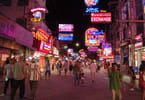Acapulco remains a huge draw for tourists, lured by its azure bay fringed by palm trees and pearly white beaches stretching for miles along the Pacific Ocean coast.
But Mexico’s drug war has tarnished this tropical getaway’s international sheen. What once was the playground of Hollywood stars is now more of a local delight.
Tourism is traditionally Mexico’s third largest source of revenue. But drug-related violence in the past 3 1/2 years has claimed some 28,000 lives and sent foreign tourists looking for other holiday destinations.
The U.S. State Department maintains a travel warning, updated last month, for Americans on the security risks of traveling to and living in Mexico.
The Way It Was
In its glory years, Acapulco was a playground for Hollywood stars and the epitome of jet-set glamour. In 1954, John Wayne and nine other celebrities bought an Acapulco hotel, Los Flamingos. While the stars are long dead, the hotel still looks out over the Pacific from the rugged cliffs.
The sunsets are still great, but the guests are few, says hotel manager Adolfo Santiago.
Santiago, who worked at the hotel back when Wayne and the other stars bought it, says the golden age was in the late 1950s. Back then, Errol Flynn, Johnny Weissmuller, Roy Rogers, Cary Grant and others came to lounge by the kidney-shaped pool.
“For me, right now business is very bad,” Santiago says. “I think for all the businesses, hotels especially, things are not good. Since last year, we’ve had a big drop. Now with all the problems we have, business is very slow.”
The problems for Acapulco and Mexican tourism nationally are bigger than just the drug violence. Last year, the swine flu outbreak crippled Mexico’s resorts for months. The downturn in the global economy also kept many tourists at home.
But Acapulco has also been a battleground where two of Mexico’s most powerful cartels have recently been fighting for control. They’ve hurled grenades at nightclubs and police stations.
In April, a shootout on the main tourist strip in Acapulco left six people dead, including a mother and her 8-year-old daughter. In June 2009, a firefight between cartel gunmen and the military left 16 people dead. In 2006, drug cartels decapitated several local policemen and put their heads outside a government building.
Over time, international tourists have migrated to other places with sand, warm weather and less violence.
Vacationing, Under Armed Guard
Now, soldiers in black ski masks patrol in front of the high-rise hotels. The state police have welded makeshift gun turrets over the cabs of their pickup trucks, and motorcycle cops drive around with long automatic rifles slung over their shoulders.
Felix Avila Diaz, the subsecretary for tourism in the surrounding state of Guerrero, says tourism is the No. 1 priority for the region. He says it’s the most important element of the state economy, and it is in serious decline.
“This was a very difficult year, not just for Acapulco or for Guerrero, but for the whole country,” he says.
Over the past two years, the number of international tourists visiting Acapulco has dropped by 33 percent. Avila says the beach resort now caters primarily to Mexicans.
“The composition of tourists has changed drastically,” he says. “It used to be that 85 to 90 percent of the tourists were foreigners. Now 85 to 90 percent are Mexican.”
WHAT TO TAKE AWAY FROM THIS ARTICLE:
- In April, a shootout on the main tourist strip in Acapulco left six people dead, including a mother and her 8-year-old daughter.
- Santiago, who worked at the hotel back when Wayne and the other stars bought it, says the golden age was in the late 1950s.
- He says it’s the most important element of the state economy, and it is in serious decline.






















